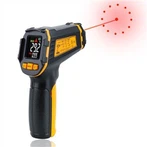How to use a multimeter to test the igbt module
1. Judgment of polarity
First, set the multimeter to the R×1K block. When measuring with the multimeter, if the resistance value of a certain pole and the other two poles is infinite, and the resistance value of the pole and the other two poles is still infinite after changing the test leads, then it is judged that the gate of this pole (G ). The remaining two poles are measured with a multimeter. If the measured resistance is infinite, the measured resistance is smaller after changing the test leads. In one measurement of the small resistance value, it is judged that the red test lead is connected to the collector (C); the black test lead is connected to the emitter (E).
2. Judging good or bad
Turn the multimeter to the R×10K block, connect the black test lead to the collector (C) of the IGBT, and connect the red test lead to the emitter (E) of the IGBT. At this time, the pointer of the multimeter is at zero. Touch the gate (G) and collector (C) with your fingers at the same time, at this time the IGBT is triggered to conduct, the pointer of the multimeter swings to the direction of the smaller resistance, and can stand and indicate at a certain position. Then touch the gate (G) and emitter (E) with your fingers at the same time, at this time the IGBT is blocked, and the pointer of the multimeter returns to zero. At this time, it can be judged that the IGBT is good.
3. Any pointer multimeter can be used to detect IGBT
Note that when judging whether the IGBT is good or bad, the multimeter must be set to the R×10K gear. Because the internal battery voltage of the multimeter below the R×1K gear is too low, the IGBT cannot be turned on when testing whether it is good or bad, and it is impossible to judge whether the IGBT is good or bad. . This method can also be used to detect whether the power field effect transistor (P-MOSFET) is good or bad.
Inverter IGBT module detection:
Turn the digital multimeter to the diode test position, and test the forward and reverse diode characteristics between the IGBT module c1 e1, c2 e2 and between the gate G and e1, e2 to judge whether the IGBT module is intact.
Take the six-phase module as an example. Remove the wires of U, V, and W phases on the load side, use the diode test gear, connect the red test lead to P (collector c1), and measure U, V, W in sequence with the black test lead, and the multimeter will display the maximum value; Connect the test lead to P, measure U, V and W with the red test lead, and the multimeter will display a value of about 400. Then connect the red test lead to N (emitter e2), measure U, V and W with the black test lead, and the multimeter will display a value of about 400; connect the black test lead to P, measure U, V and W with the red test lead, and the multimeter will display the maximum value. The forward and reverse characteristics of each phase should be the same. If there is a difference, it means that the performance of the IGBT module has deteriorated and should be replaced. When the IGBT module is damaged, only a breakdown short circuit occurs.
The red and black test leads respectively measure the positive and negative characteristics between the grid G and the emitter E, and the values measured by the multimeter are the maximum twice, and it can be judged that the gate of the IGBT module is normal. If there is a numerical value displayed, the performance of the gate electrode is deteriorated, and the module should be replaced. When the positive and negative test results are zero, it means that the detected phase gate has been broken down and short-circuited. When the gate is damaged, the voltage regulator tube protecting the gate of the circuit board will also break down and be damaged.






